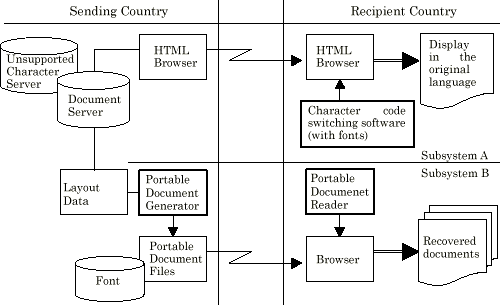[ Index | Previous
|
Next ]
4. System Implementation
4.1 The Design concept
There is a great diversity of languages and scripts in Asia-Pacific region.
But there is still a limited availability of communication tools on the
internet for peoples in the region. As its final goal, our project aims
to provide language-independent communication tools for users with any
language requirements in the region. These kind of tools will have multilingual
capability and will provide a bridge between any two users with different
languages and scripts in the region.
This report is prepared as the first step in our efforts towards this
goal. The system described in this report is designed to provide a minimum
communication tool, for users in the region who want to communicate by
their own languages and scripts. Although the system does not have multilingual
capability, it can handle any language and script by switching the code
tables of the system. This report does not include code tables. We are
expecting that relevant authorities will provide their code tables.
4.2 System structure
The system structure is shown in Figure 4.1. Its implementation is based
on the requirements for supporting the environments:
-
originator: Japan
-
recipient: Peru
-
language of recipient: Japanese
-
operating system: Spanish OS
 |
Figure 4.1
Documents are described in HTML and interchanged in the system. Its
major purpose is to forward a great number of stored legacy documents without
any additional processing and to receive them, preserving their formatting
style and font rendering.
4.2.1 Key component
The major functionality of the system is incorporated in its receiving
end. A conventional browser may incorrectly render the documents which
contain other language(s) than English and other optionally specified ones,
since the browser does not always support the characters/glyphs and fonts
for those languages which the originator wishes.
This system introduces a utility software for switching character/glyph
sets with their appropriate fonts' data. The software is obtained by downloading
via the Internet.
The utility software can identify the coded character sets of received
documents and let the documents be processed with the identified character
and embedded font resources in order to make a correct rendering.
4.2.2 Specification of utility software
-
environment
-
- MS Windows 95 or MS Windows 3.1
-
- hard disk area more than 12MB
-
- CD-ROM
-
support application
-
- Netscape Navigator 2.0 or higher
-
- MS Internet Explorer 3.0 or higher
-
- Lotus cc:Mail 1.12 or higher
-
- Eudora 2.2 or higher
-
operation
-
- Select the language switch on the popup menu to get the desired language
support.
[ Index | Previous
|
Next ]

